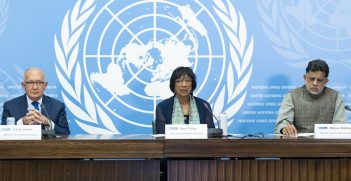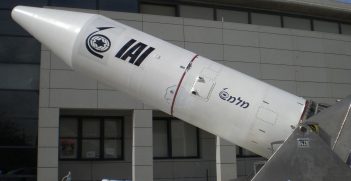The Hezbollah-Israel War of 2024: Escalation as De-escalation?

Rockets are now being fired by Iran into Israel. This turn of events raises new questions: will Israel’s strategy of degrading Hezbollah work, lead to a full blown regional war, or be a game changer in the Middle East?
One year after the horrific attacks by Hamas on Israel on 7 October 2023, Tel Aviv has now opened a second front in the North, launching air and ground attacks against Hezbollah targets in South Lebanon. This has followed a successful “decapitating strategy,” which eliminated the whole of Hezbollah’s command and control structure, including its leader, Hassan Nasrallah.
While Israel seems to be ready to go all in by launching ground operations into South Lebanon, it continues to attack and degrade the so called Iranian Axis of Resistance of Hamas in Israel, the Houthis of Yemen, Hezbollah in Lebanon, and Iran’s Iranian Republican Guard Corps in both Lebanon and Syria.
Iran’s main proxies and allies—Hamas, Hezbollah and to a certain extent the Houthis—are being systematically targeted and militarily degraded by Israel.
Hezbollah’s decapitation
Israel’s ingenious pager attack against thousands of Hezbollah operatives on 17 September (which was followed by attacking hand-held two way radios the next day) was not only a clever supply chain infiltration, but one of the most sophisticated, intelligence driven, surgically targeted strikes executed in modern military history.
These attacks were the prelude to the second phase of Israel’s decapitation strategy, when IDF airpower targeted (Operation “New Order”) and eliminated Hezbollah’s military leadership and several other high-ranking leaders. While intelligence driven and highly successful, these operations came at a substantial cost in terms of civilian losses.
Hezbollah’s line of communications, morale, and discipline has suffered dramatically. All told, Israel’s second phase (“Operation Northern Arrows”) has targeted at least 1,600 sites, including leadership, storage facilities, manufacturing plants, and personnel, genuinely degrading Hezbollah’s warfighting capabilities.
Iranian retaliation
Iran has frequently threatened to retaliate against Israel over the last 12 months; the last time after the assassinations of Hamas leader Ismail Haniyeh in Tehran and Hezbollah commander Fouad Shukr in Beirut in July 2024. It did attack Israel in April with hundreds of missiles and drones with only minor damage and casualties. As much as 99 percent of these projectiles were intercepted by Israel and its US led allies.
Perhaps given Tehran’s awareness of Israel’s airpower escalation dominance, its leaders initially seemed to be unable and unwilling to respond to Israel’s military actions in Lebanon. Fears of a full Israeli (possibly US backed) counterstrike were also likely. Netanyahu warned the Iranian regime that “there is nowhere in the Middle East Israel cannot reach” while explicitly addressing the Iranian people with his hope for a future Iran freed from its current Islamic regime. With Iran’s extensive missile barrage of 1 October it has become clear that Iran has decided to take the risk and attack. While this attack was again unsuccessful in terms of impact, Israel has vowed to retaliate stronger and more “painful” as it did April. This could lead to an escalation despite Washington’s attempts to defuse the situation.
One consideration for Iran as the seventh-largest global oil producer is to weaponise oil, such as OPEC did during the 1973 Arab-Israeli war. Another is to intensify attacks on international shipping in the Red Sea through its proxy, the Houthis. Such steps would further impact global trade and the world economy, still recovering from the COVID-19 pandemic and other global flashpoints of conflict.
Wider regional war or a decisive win for Israel?
The big question is what happens next? Israel will continue its operations against Hezbollah in Lebanon until its capabilities are degraded to the point that it will not constitute a direct threat to Israel and its people. Netanyahu’s “de- escalation through escalation” is clear in its war objectives: the return of those 60,000 Israelis to the North of Israel, forced to evacuate when Hezbollah began firing indiscriminate rockets into Israel following 7 October.
With 7 October massacre, Israel and its government have now shown that it will not accept any “red lines” on escalation, nor any interference from Washington, its most important military and strategic ally. Given that US support will continue independently of who will win the US elections this year, any US calls for de-escalation and ceasefire will likely have little effect.
Early reports from the ground incursion indicate heavy fighting between the IDF and Hezbollah. Even when considering the substantial early wins for Israel, Hezbollah and its (at least) 30,000 fighters are likely to put up a stiff resistance. Since the 2006 war, Hezbollah has built tunnels and fortifications in South Lebanon and honed its fighting skills in the war in Syria. Whether Israel expands on its ground operations by extending its limited incursion into a full blown invasion remains to be seen.
What is clear is that this war will come at a high cost in terms of civilian casualties. According to Lebanese government figures, over 2000 civilians have been killed so far since 8 October when Israel began retaliating against Hezbollah’s attacks—already to the tune of 9000 missiles. These numbers include a growing percentage of civilian deaths which will increase while the fighting intensifies.
A diplomatic solution? Unlikely
International leaders, including those in the European Union, have called for an “immediate ceasefire between Hezbollah and Israel, and for both parties to commit to the full and symmetrical implementation of the UN Security Council resolution 1701 of 2006, so as to ensure the safe return of displaced populations on both sides, as part of a broader negotiated settlement.” Such a ceasefire would require the robust policing of a buffer zone between the north of Israel and the Litani river by the Lebanese Army and UNIFIL (the UN peacekeeping force present in Lebanon since 1978) as required under Resolution 1701.
Will Prime Minister Benjamin Netanyahu eventually agree to a brokered ceasefire with Hezbollah forced to leaving the territory North of the Israeli-Lebanon border and the Litani river as UNSC Resolution 1701 of August 2006 requires? Given that the Lebanese Army is rather weak militarily, with some reports indicating that it has been infiltrated by Hezbollah, and the fact that UNIFIL has only a monitoring role, there is little chance that Israel will agree to any such ceasefire any time soon.
Before this backdrop we can expect that the conflict in Israel and the Middle East will get worse before (at least temporary) a solution can be found.
Sascha-Dominik (Dov) Bachmann is Professor in Law and Co-Convener National Security Hub at the University of Canberra, and a Research Fellow with the Security Institute for Governance and Leadership in Africa, Faculty of Military Science, Stellenbosch University.
This article is published under a Creative Commons Licence and may be republished with attribution.





